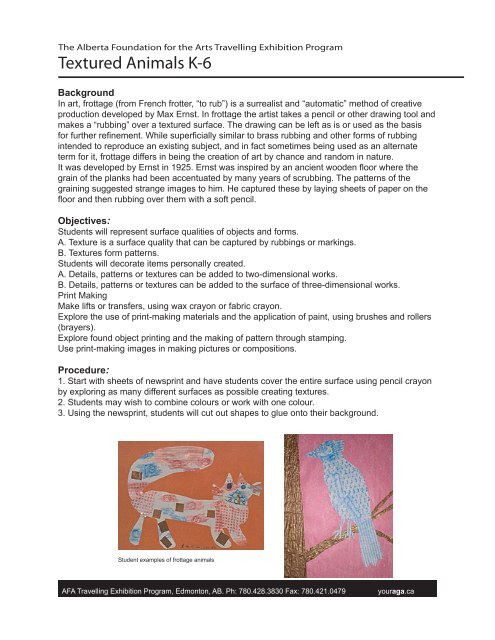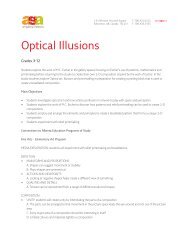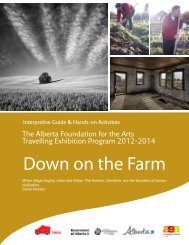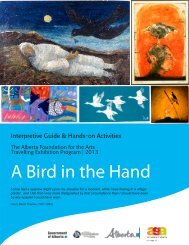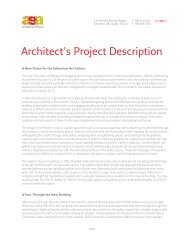Urban Animals - Art Gallery of Alberta
Urban Animals - Art Gallery of Alberta
Urban Animals - Art Gallery of Alberta
You also want an ePaper? Increase the reach of your titles
YUMPU automatically turns print PDFs into web optimized ePapers that Google loves.
The <strong>Alberta</strong> Foundation for the <strong>Art</strong>s Travelling Exhibition Program<br />
Textured <strong>Animals</strong> K-6<br />
Background<br />
In art, frottage (from French frotter, “to rub”) is a surrealist and “automatic” method <strong>of</strong> creative<br />
production developed by Max Ernst. In frottage the artist takes a pencil or other drawing tool and<br />
makes a “rubbing” over a textured surface. The drawing can be left as is or used as the basis<br />
for further refinement. While superficially similar to brass rubbing and other forms <strong>of</strong> rubbing<br />
intended to reproduce an existing subject, and in fact sometimes being used as an alternate<br />
term for it, frottage differs in being the creation <strong>of</strong> art by chance and random in nature.<br />
It was developed by Ernst in 1925. Ernst was inspired by an ancient wooden floor where the<br />
grain <strong>of</strong> the planks had been accentuated by many years <strong>of</strong> scrubbing. The patterns <strong>of</strong> the<br />
graining suggested strange images to him. He captured these by laying sheets <strong>of</strong> paper on the<br />
floor and then rubbing over them with a s<strong>of</strong>t pencil.<br />
Objectives:<br />
Students will represent surface qualities <strong>of</strong> objects and forms.<br />
A. Texture is a surface quality that can be captured by rubbings or markings.<br />
B. Textures form patterns.<br />
Students will decorate items personally created.<br />
A. Details, patterns or textures can be added to two-dimensional works.<br />
B. Details, patterns or textures can be added to the surface <strong>of</strong> three-dimensional works.<br />
Print Making<br />
Make lifts or transfers, using wax crayon or fabric crayon.<br />
Explore the use <strong>of</strong> print-making materials and the application <strong>of</strong> paint, using brushes and rollers<br />
(brayers).<br />
Explore found object printing and the making <strong>of</strong> pattern through stamping.<br />
Use print-making images in making pictures or compositions.<br />
Procedure:<br />
1. Start with sheets <strong>of</strong> newsprint and have students cover the entire surface using pencil crayon<br />
by exploring as many different surfaces as possible creating textures.<br />
2. Students may wish to combine colours or work with one colour.<br />
3. Using the newsprint, students will cut out shapes to glue onto their background.<br />
Student examples <strong>of</strong> frottage animals<br />
AFA Travelling Exhibition Program, Edmonton, AB. Ph: 780.428.3830 Fax: 780.421.0479<br />
youraga.ca


